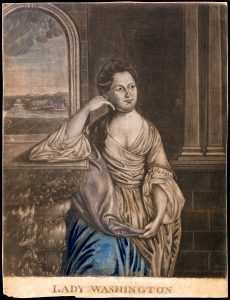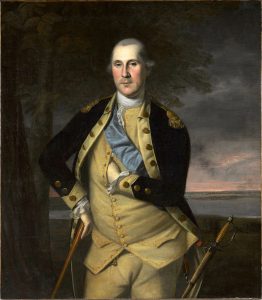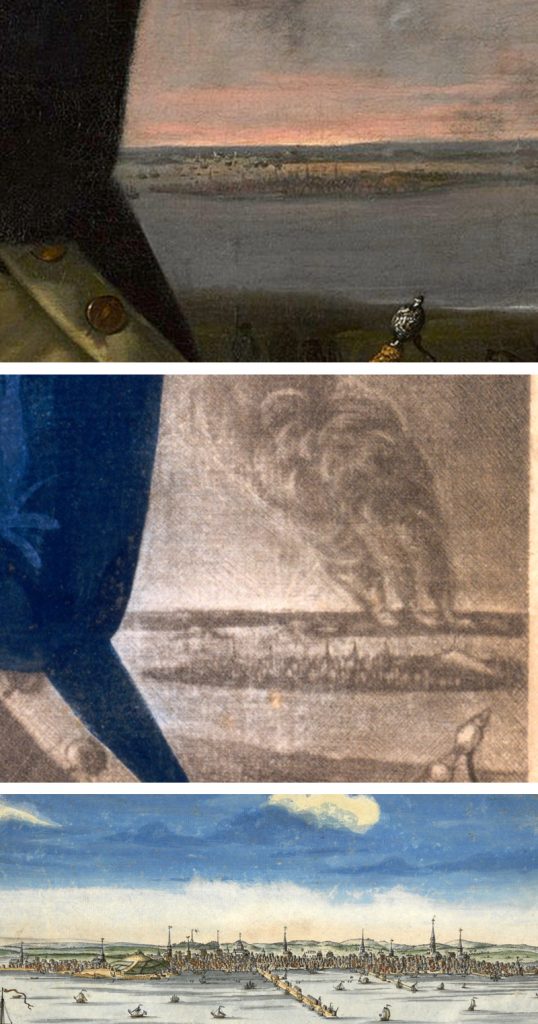The exceedingly rare mezzotint of His Excellency George Washington Esqr (above) listed by Charles Hart as no. 1 in his Catalogue of the Engraved Portraits of Washington, a seminal work published in 1904, has long been considered by collectors as the most prized of all the portraits of Washington. Among other reasons, it is the first engraved print of the hero of the American Revolution and our country’s first president published in this country.

Wendy Shadwell made the reasonable surmise in 1969, when she was assistant curator of prints at the New-York Historical Society, that this print and the companion print of Lady Washington were engraved by Joseph Hiller (1748-1814).[1] Collector and print historian J. Robert Maguire, however, later argued for Samuel Blyth (1744-1795), a Salem painter of houses, chaises, coats-of-arms, and maker of mezzotints.[2] Maguire had discovered a previously-unpublished note made almost a century earlier by the collector Hall Park McCullough, who had inspected the Washington print in 1908, and in an unpublished memorandum noted the similarity to three unique mezzotints that were attributed to Samuel Blyth in the 1904 sale of the celebrated Alfred S. Manson Collection. “It was ptd [painted] the same way,” McCullough wrote, referring to the “contemporary style” of hand-coloring mezzotints with liquid-soluble crayon, concluding that they “may all be by Blythe.”

McCullough’s assessment of the technique is true, especially the use of heavy strokes of white, which Blyth often used. What is also clear is that the inscription below the print is similar to many other inscriptions on prints attributable to Blyth. Nonetheless, the finely drawn, detailed draftsmanship of the figure of the general, along with the well-executed landscape, particularly the foliage and the drum hanging from a tree branch, are more skillful than found in any mezzotint attributable to Samuel Blyth. Washington’s portrait is based on the full-length painting by Charles Willson Peale commissioned by John Hancock in 1776, when Peale spent most of that year with his family in Charlestown, Massachusetts.[3] At about the same time, Hiller made a mezzotint of Hancock, copied from the portrait of him by John Singleton Copley. So there is good reason to assume that Hiller did a copy of the Peale portrait of Washington as well. Attribution of the print of His Excellency George Washington Esqr , as Shadwell proposed, belongs with Hiller, as does that of Lady Washington.
An intriguing detail that seems never to have been noted in any published work dealing with this print is what is seen in the distant landscape beyond the general’s left arm, an image that Charles Hart referred to as an island.[4] It actually shows many spires and at the far right, the identifiable three-legged “beacon” on a hill. The vignette appears in the oil portrait by Peale as well, although it also had not previously been identified. It proves to be a simplified view of Boston, a peninsula at the time, without Long Wharf or vessels in the harbor. Peale used as his source the well-disseminated view issued by William Price in 1743, which incorporated many new church spires and other buildings, along with Charlestown in the rear, an update of the 1725 William Burgis view.[5] That this background landscape in the painting has escaped mention is especially surprising, as Peale is known for his care to details. Several writers noted that he included a view of buildings of Princeton College in another of his Washington oil portraits.

Hiller, however, added yet another element to the scene in his mezzotint—three dark, streaming clouds of smoke rising from the ground. It is Charlestown on fire. Hiller was reminding viewers that the town had been almost totally destroyed by the British forces during the Battle of Bunker Hill, at which the town also lost one of its most revered men, Gen. Joseph Warren. General Washington could therefore be said to be standing on Dorchester Heights, from which his troops forced the British out of Boston in March, 1776. That event itself catapulted the general into the hearts of the colonists, but the depiction of the Charlestown fire surely reminded Bostonians of another reason for the rebellion against British rule.
[1]Wendy Shadwell, “His Excellency and Lady Washington,” Antiques (February 1969), 240-241. Shadwell became Assistant Curator, then Curator of Prints at the New-York Historical Society. The portrait of Washington is Hart #1. Charles Henry Hart, Catalogue of the Engraved Portraits of Washington (New York: The Grolier Club, 1904), 3. Both are cited in J. Robert Maguire, “His Excellency and Lady Washington:A Pair of Mezzotint Portraits by Joseph Hiller, Sr., or Samuel Blyth?,” Imprint Vol. 30, no. 2 (Autumn 2005), 22-33. Collectors Nina Fletcher and Bertram K. Little also agreed that the work could be attributed to Samuel Blyth. However, the description of the pair in the Sotheby’s sales catalogue of the Little collection in 1994 cited what she had earlier written on a label, crediting Hiller. The pair sold for $3,000, double the top estimate selling price. More than half a century earlier, Boston book and print dealer Charles E. Goodspeed wrote that he paid more than he had expected to, although he considered it a “fair risk,” for what he realized were an “excessively rare” pair of early portraits of the Washingtons. Charles E. Goodspeed,Yankee Bookseller (Boston, Houghton Mifflin company, 1937).
[2]Maguire, “His Excellency and Lady Washington.”
[3]Charles Coleman Sellers, Charles Willson Peale (New York: Charles Scribner’s Sons, 1969) 118-119, 122.
[4]Hart, Catalogue of the Engraved Portraits of Washington. “In the right distance a river, an island with buildings, and flames arising from the far shore,” 3.
[5]South East View of ye Great Town of Boston in New England in America, drawn by William Burgis and engraved by J. Harris, 1725. There are two known states, the second from 1742-3; and the first state in the British Museum copy has added paste-ons for newer buildings, dating it to after 1736. Price reissued it, incorporating the new buildings, in 1743. See John W. Reps, “Boston by Bostonians: The Printed Plans and Views of the Colonial City by its Artists, Cartographers, Engravers, and Publishers,” and Richard B. Holman, “William Burgis,” both in Boston Prints and Printmakers (Boston; The Colonial Society of Massachusetts, 1973), 35-42, 62-63.










3 Comments
Bettina, Interesting insights! Do you think that Heller as a Massachusetts native was more attuned to the local situation and added the fire smoke to the Marylander’s work? Washington must have liked Heller’s work as he appointed him as Salem customs collector.
Heller also did a mezzotint of Israel Putnam as a hero at the Battle of Bunker Hill, so he was proud of the Boston battles and there was a good market for his products.
Sorry! I just realized that the article had comments. Dumb me. It’s Hiller, by the way, not Heller. I certainly do know the print. It was from an original by Benjamin Blyth, Samuel’s brother. Hiller is a most interesting fellow. I have several paragraphs on him in a book I am about to publish… What is your role in history
outside of this site?
Sorry that it haas taken me so long to see this response. I have been dealing with a very sad family situation, now supposedly eased. Thank you for your interest. Hiller definitely added the smoke. Indeed, Hiller was popular. I deal with him far more extensively, of course, in my forthcoming book.